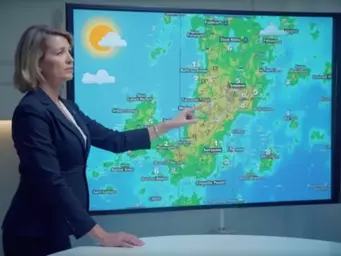How often do you find yourself checking the weather forecast before making plans? Meteorologists are the unsung heroes behind those forecasts, shaping our daily decisions and preparing us for weather-related challenges. The field of meteorology offers a diverse range of career paths, and understanding its core principles can open doors to exciting opportunities.
What You Will Learn
- Meteorologists play a crucial role in agriculture, emergency management, and public safety in Australia.
- Mathematics, including calculus and statistics, is essential for interpreting weather data and making accurate forecasts.
- A solid understanding of physical sciences, such as thermodynamics and fluid dynamics, is vital for grasping atmospheric behavior.
- Proficiency in meteorological software and tools like WRF and GIS enhances data analysis capabilities.
- Remote sensing technologies, including Doppler radar and satellite imagery, are essential for accurate weather forecasting.
- Understanding weather models and their applications can significantly enhance forecasting skills and accuracy.
- Essential skills for aspiring meteorologists include analytical thinking, effective communication, and teamwork.
- Hands-on experience through internships or volunteering at local weather stations is crucial for career development in meteorology.
Essential Skills for Aspiring Meteorologists
Meteorology is a dynamic field requiring a blend of scientific understanding, technical proficiency, and effective communication. The visual below outlines the key skill categories vital for success in this career.
Skill Categories for Meteorologists
A successful meteorologist masters a diverse set of skills, from foundational sciences to modern technical tools and crucial soft skills.
1. Mathematical & Physical Sciences
- Calculus & Statistics: Data analysis & modeling.
- Atmospheric Dynamics: Understanding changes.
- Thermodynamics & Fluid Dynamics: Atmospheric behavior.
2. Software & Remote Sensing
- WRF, GIS, Python/R: Data analysis & visualization.
- Doppler Radar & Satellite: Real-time data.
- Weather Models (NWP): Forecasting future conditions.
3. Thinking & Problem-Solving
- Data Interpretation: Drawing insights from complex data.
- Critical Decision-Making: Especially in critical situations.
- Forecasting Accuracy: Refining predictions consistently.
4. Communication & Adaptability
- Effective Communication: Clear reporting to public.
- Teamwork & Adaptability: Collaborative work, evolving tech.
- Time Management: Meeting critical deadlines.
Understanding the Role of a Meteorologist
Have you ever thought about how meteorologists impact our daily lives? They play a vital role in society by providing forecasts that help us prepare for everything from daily activities to extreme weather events. In Australia, meteorologists are crucial for agriculture, emergency management, and public safety. The diverse career paths in this field range from research and education to broadcasting and environmental consulting, each offering unique opportunities.
As the founder of the Meteorologist Career Guide, I’ve seen firsthand the growing interest in meteorology. It’s exciting to witness aspiring meteorologists discovering their passion and understanding the significance of their work! Whether you're just starting or considering a career change, there’s a path for everyone.
Core Scientific Foundations Essential for Meteorologists
Mathematical Proficiency: The Backbone of Meteorology
Mathematics is more than just numbers; it’s essential in meteorology! Proficiency in calculus, statistics, and atmospheric dynamics forms the backbone of weather analysis. These skills allow meteorologists to interpret complex data and create accurate forecasts that inform the public and stakeholders. A strong background in mathematics, as outlined in the American Meteorological Society's recommendations for atmospheric science degrees, is often a prerequisite for advanced studies and professional roles.
- Calculus: Helps in understanding changes in atmospheric conditions.
- Statistics: Essential for analyzing weather patterns and trends.
- Atmospheric Dynamics: Provides insights into how different atmospheric processes interact.
As I often tell my students, embracing these mathematical concepts can be challenging, but they are key to unlocking the mysteries of our atmosphere. With a solid foundation in math, you can confidently tackle various meteorological challenges!
Physical Sciences: Understanding Atmospheric Behavior
Physics plays a critical role in understanding how our atmosphere behaves. It helps meteorologists grasp the forces behind phenomena like temperature changes, pressure variations, and wind patterns. By studying these physical principles, you’ll gain a deeper appreciation of how weather systems develop and evolve. The U.S. Office of Personnel Management's qualification standards for meteorologists emphasize the importance of a comprehensive understanding of physical science principles, including thermodynamics and fluid dynamics.
- Thermodynamics: Understanding heat transfer in the atmosphere.
- Fluid Dynamics: Analyzing airflow and its effects on weather systems.
- Radiative Transfer: Examining how energy moves through the atmosphere.
These physical science principles are crucial for accurate weather predictions. When you grasp the underlying physics, you’ll be better equipped to explain complex weather phenomena to your audience!
Technical Skills for Modern Meteorology
Proficiency in Meteorological Software and Data Analysis
In today’s tech-driven world, being proficient in meteorological software is essential. Tools like WRF (Weather Research and Forecasting), GRIB files, and GIS (Geographic Information Systems) are commonly used in the field. Understanding how to leverage these tools enhances your ability to analyze and interpret vast amounts of data quickly.
- WRF: A widely used model for simulating weather patterns.
- GIS: Helps visualize data spatially, making it easier to interpret.
- Data Analysis Tools: Software like Python and R are increasingly popular for weather data analysis.
The ability to use these tools effectively can set you apart in the job market! As a dedicated educational advocate, I encourage students to gain hands-on experience with these platforms to build their confidence and skills.
Remote Sensing Technologies
Remote sensing technologies, including Doppler radar and satellite imagery, are vital for gathering crucial weather data. These technologies provide real-time information that enhances our ability to forecast weather accurately. Understanding how to interpret this data is an invaluable skill for meteorologists.
- Doppler Radar: Measures precipitation and wind patterns.
- Satellite Imagery: Offers a global view of weather systems.
- Weather Balloons: Collects atmospheric data at different altitudes.
With these advanced technologies, meteorologists can make more informed predictions and communicate effectively with the public. It’s exciting to see how these tools evolve and improve our understanding of weather!
Understanding Weather Models and Their Applications
Weather models are essential for forecasting rain, storms, and temperature changes. These models use mathematical equations to simulate the atmosphere, helping meteorologists predict future weather conditions. Understanding how to develop and utilize these models can significantly enhance your forecasting abilities!
- NWP (Numerical Weather Prediction): A powerful tool that predicts weather based on current atmospheric conditions.
- Climate Models: Help scientists understand and predict long-term weather patterns.
- Ensemble Forecasting: Uses multiple simulations to improve accuracy.
As budding meteorologists, getting familiar with these models is crucial for success in this field. By learning to interpret model outputs, you can improve your forecasting skills and provide more accurate information to your audience!
We Want to Hear From You!
As you consider your own journey toward becoming a meteorologist, what aspects of this field excite you the most? Is it the thrill of forecasting extreme weather, or perhaps the challenge of data analysis? Share your thoughts below:
Frequently Asked Questions about Becoming a Meteorologist
What role do meteorologists play in daily life?
Meteorologists provide crucial weather forecasts that help individuals and industries prepare for daily activities and extreme weather events, impacting sectors like agriculture, emergency management, and public safety.
What mathematical skills are essential for meteorologists?
Proficiency in calculus, statistics, and atmospheric dynamics is vital for interpreting complex data, analyzing weather patterns, and creating accurate forecasts.
Why are physical sciences important in meteorology?
Understanding physical science principles like thermodynamics, fluid dynamics, and radiative transfer helps meteorologists grasp the forces behind atmospheric behavior, such as temperature, pressure, and wind patterns, enabling more accurate predictions.
What technical software should aspiring meteorologists be familiar with?
Essential software includes WRF (Weather Research and Forecasting), GIS (Geographic Information Systems), and data analysis tools like Python and R, which are used for data interpretation, visualization, and modeling.
How do remote sensing technologies contribute to weather forecasting?
Technologies such as Doppler radar and satellite imagery provide real-time data on precipitation, wind patterns, and global weather systems, significantly enhancing the accuracy and timeliness of weather forecasts.
What are weather models, and why are they important?
Weather models, including Numerical Weather Prediction (NWP) and climate models, use mathematical equations to simulate atmospheric conditions and predict future weather. Understanding these models is crucial for enhancing forecasting abilities and providing accurate information.
What soft skills are important for meteorologists?
Effective communication (for clear reporting to the public), teamwork, adaptability (to evolving technology), analytical thinking, and time management are crucial for success in the field.
How can aspiring meteorologists gain practical experience?
Seeking internships, volunteering at local weather stations, and engaging in relevant courses are excellent ways to gain hands-on experience and strengthen scientific foundations and software proficiency.
Summarizing the Essential Skills for Aspiring Meteorologists
As we explore the journey toward becoming a meteorologist, it's essential to recognize the vital skills that pave the way for success in this field. From a firm grasp of mathematics and physical sciences to technical prowess with meteorological software, each skill plays a crucial role. Communication skills, both written and verbal, are equally important for conveying complex weather information effectively.
Moreover, analytical thinking and problem-solving abilities enable meteorologists to interpret data and make informed decisions, especially during critical situations. The landscape of meteorology is continuously evolving with emerging technologies, making it vital for aspiring meteorologists to stay on top of trends like AI and machine learning. Below are the key skills we've discussed:
- Mathematical Proficiency: Essential for data analysis and weather modeling.
- Physical Sciences Knowledge: Helps understand atmospheric phenomena.
- Technical Skills: Proficiency in software and tools for forecasting.
- Analytical Thinking: Critical for interpreting complex data.
- Effective Communication: Necessary for clear reporting and public presentations.
- Soft Skills: Teamwork, adaptability, and time management.
Next Steps for Aspiring Meteorologists
Now that you have a clearer picture of the skills necessary for a successful career in meteorology, what’s next? It's time to take proactive steps towards developing these skills and pursuing opportunities in the field! Start by seeking internships or volunteering for local weather stations; this hands-on experience will be invaluable. Additionally, consider enrolling in relevant courses to strengthen your scientific foundations and software proficiency.
Don't forget to reach out to professionals in the field, as they can offer mentorship and guidance. Have you thought about joining a local meteorological society? These communities are fantastic for networking and can help you stay updated on industry trends. Taking the initiative today can set you on the right path toward your dream career in meteorology!
Additional Resources for Further Learning
To help you further in your meteorology journey, I've compiled a list of valuable resources that you can explore:
- American Meteorological Society: A great resource for professional development and certifications.
- National Weather Service: Offers internship opportunities and educational materials.
- University Course Comparisons: Find the right meteorology programs suited to your interests.
- Climate.gov: For insights into climate change and its implications in meteorology.
- LinkedIn Groups: Join discussions, connect with mentors, and find job postings.
These resources are just the beginning of what’s available to you. By actively engaging with these materials and communities, you will build a solid foundation for your meteorological career. Remember, at the Meteorologist Career Guide, we’re here to support your journey every step of the way!
Recap of Key Points
Here is a quick recap of the important points discussed in the article:
- Mathematical Proficiency: Essential for data analysis and weather modeling, including skills in calculus, statistics, and atmospheric dynamics.
- Physical Sciences Knowledge: Important for understanding atmospheric phenomena through principles of thermodynamics, fluid dynamics, and radiative transfer.
- Technical Skills: Proficiency in meteorological software and data analysis tools like WRF, GIS, Python, and R.
- Remote Sensing Technologies: Utilizing Doppler radar and satellite imagery for accurate weather forecasting.
- Understanding Weather Models: Familiarity with NWP, climate models, and ensemble forecasting to improve prediction accuracy.
- Effective Communication: Necessary for clearly conveying complex weather information to various audiences.








